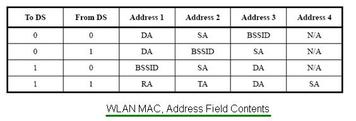802.11 WLAN MAC Frames: Control, Data, and Management
Advertisement
This article describes the different types of 802.11 WLAN MAC frames, specifically control frames, data frames, and management frames. Control frames include acknowledgement (ACK) frames and Request to Send/Clear to Send (RTS/CTS) frames. Management frames consist of Authentication frames, Association Request/Response frames, Beacon frames, De-authentication frames, Disassociation frames, Probe request/response frames, and Re-association request/response frames.
WLAN MAC Control Frames
WLAN MAC defines two main frame types for control functionalities: Acknowledgement frames and RTS/CTS frames. The sub-fields within the frame control field of control frames are illustrated below.
Both control frame types follow a similar format:

These control frames manage the exchange of data frames between stations (STAs). Here’s a closer look at some essential control frames:
-
ACK (Acknowledgement) Frame: The receiving station sends an ACK frame to the sending station upon successful reception of data without errors. If the transmitting station doesn’t receive the ACK within a predetermined timeframe, it re-sends the data frames.
-
RTS/CTS Frames: The RTS (Request to Send) and CTS (Clear to Send) frames implement an optional collision reduction mechanism, particularly useful for Access Points (APs) with hidden stations (STAs). When a WLAN node needs to send a frame, it first sends an RTS frame. This serves two purposes: reserving the RF link for the sending station and notifying other stations to refrain from transmitting. The target station, upon receiving the RTS, responds with a CTS frame. Like the RTS, the CTS informs nearby stations to remain silent and avoid RF transmissions.
WLAN MAC Data Frames
The data frame format is outlined in the following figure:

The content of the Address fields within the data frame depends on the values of the “To DS” and “From DS” bits. When a field’s content is marked as NA (not applicable), the respective field is omitted.
Note 1: Address-1 always contains the RA (Receiver Address) of the intended receiver(s), such as in multicast operations.
Note 2: Address-2 always holds the address of the STA transmitting the MAC frame.
WLAN MAC Management Frames
WLAN MAC includes specific frame types for management functionalities: Authentication/De-authentication, Association Request/Response, Beacon, Disassociation, Probe request/response, and Re-association request/response frames.
All management frames adhere to the following format:

A station utilizes the contents of the address-1 field for address matching during receive operations. When address-1 contains a group address and the frame type is not a beacon frame, the BSSID is validated to ensure the broadcast/multicast originates from the same BSS.
-
Authentication Frame: WLAN authentication starts with the WNIC (Wireless Network Interface Card) sending an authentication frame to the AP, including its identity.
-
Association Request Frame: This frame is sent by a STATION. It enables the AP to allocate resources and synchronize. The frame includes information about the WNIC, supported data rates, and the SSID of the network the station wants to associate with. If the request is accepted, the AP reserves memory and establishes an association ID for the WNIC.
-
Association Response Frame: The AP transmits this frame to a STA, indicating the acceptance or rejection of the Association Request Frame. If accepted, the frame’s information field contains the association ID and supported data rates.
-
Beacon Frame: An AP periodically sends this frame to announce its presence, providing the SSID and other information to WNICs within its range.
-
De-authentication Frame: This is sent from a STA to terminate a connection with another STATION.
-
Disassociation Frame: Sent from a station wanting to terminate a connection. This method allows the AP to de-allocate memory and remove WNIC details from the association table.
-
Probe Request Frame: A Station sends this frame when it needs information from another station.
-
Probe Response Frame: An AP sends this frame in response to a probe request, including capability information and supported data rates.
-
Re-association Request Frame: A WNIC sends a re-association request when it moves out of range of its currently associated AP and finds another AP with a stronger signal. The new AP coordinates the forwarding of any buffered information from the previous AP.
-
Re-association Response Frame: Sent by an AP to indicate acceptance or rejection of a re-association request. The frame includes the association ID and supported data rates.
Advertisement
 RF
RF



